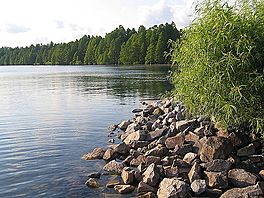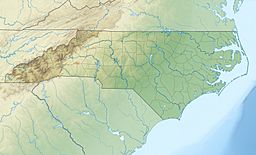Lake Phelps facts for kids
Quick facts for kids Lake Phelps |
|
|---|---|
 |
|
| Location | Washington / Tyrrell counties, North Carolina, United States |
| Coordinates | 35°46′12″N 76°27′29″W / 35.7701°N 76.4580°W |
| Primary inflows | precipitation |
| Basin countries | United States |
| Managing agency | North Carolina Division of Parks and Recreation |
| Designation | State Lake |
| Surface area | 16,600 acres (67 km2) |
| Average depth | 4.5 ft (1.4 m) |
| Max. depth | 9 ft (2.7 m) |
Lake Phelps is a really cool natural lake in North Carolina. It's the second largest natural lake in the state! This big lake covers about 16,600 acres (which is about 67 square kilometers). You can find it mostly in Washington County, but a small part also reaches into Tyrrell County. The lake is located on the Albemarle-Pamlico Peninsula, which is a piece of land between the Albemarle Sound and the Pamlico Sound.
Scientists have found amazing things in and around Lake Phelps. An old Native American dugout canoe was discovered in the lake. It's almost 4,400 years old! Other ancient tools and items have been found nearby, some dating back as far as 8,000 B.C. This shows that people have lived and used this area for a very long time.
How Lake Phelps Formed
The way Lake Phelps was created has been a mystery for a long time. Scientists have many ideas about its origin. Some think it might have formed from underground springs. Others believe it was shaped by strong winds or waves. Some even suggest it could have been made by a meteor hitting the Earth! Another idea is that it formed from a large peat burn, which is when a lot of plant material underground catches fire and burns away.
The lake is mostly round in shape. This roundness is one reason why its formation is so interesting to scientists.
How Lake Phelps Got Its Name
Lake Phelps is named after a man named Josiah Phelps. He was the first European settler to enter the lake's waters. This happened in 1755. Josiah Phelps and another explorer, Benjamin Tarkington, were exploring a huge swampy area. This area was known back then as the Great Eastern Dismal or Great Alligator Dismal.
Phelps and Tarkington were part of a group of hunters. They had entered the swamps looking for animals to hunt and good farmland. The group was getting tired and ready to give up. But then, Benjamin Tarkington climbed one of the tall trees. From the top, he spotted the lake a short distance away!
Josiah Phelps went ahead and was the first to run into the water. Because he was the first, he got the honor of naming the lake. That's how it became Lake Phelps!
Protecting Lake Phelps
Lake Phelps became a North Carolina State Lake in 1929. This means it's a special natural area protected by the state. The lake is managed by Pettigrew State Park, which is right next to it. This helps make sure the lake and its surrounding environment are kept safe and healthy for everyone to enjoy.



